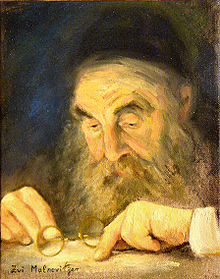Zvi Malnovitzer
His upbringing in a society isolated from the modern world, where he was dedicated to intensive and uninterrupted Talmudic study from a young age, makes his decision to become an artist unusual, bold, and one of accomplishment.During his training in Reichenau, Austria, where he studied under the auspices of artist Wolfgang Manner and under the direction of Ernst Fuchs (renowned exponent of Fantastic Realism, a 20th-century group of artists in Vienna combining techniques of the Old Masters with religious and esoteric symbolism), Malnvotizer developed a unique style portraying themes that straddle the religious and secular worlds.[1] While Malnovitzer's work is inspired by the prolific portraits of Rembrandt van Rijn (1606–1669) and the Romanticism of Francisco de Goya (1746–1828), his style is unique in that it combines European Expressionism with traditional and religious themes.Young Zvi's talents were soon recognized by his neighbor in Bnei Brak and accomplished Israeli artist, Yehuda Wallersteiner, who agreed to be his teacher at age 13.Wallensteiner taught the young artist the fundamentals of painting in the heart of the Haredi city of Bnei Brak, a society that observes Jewish law so strictly that art is rare.Full of passion from his experiences with and exposure to European Masters of painting, he sold his house and car to support his full-time vocation as an artist.[9] Malnovitzer's style is an Expressionism inspired by the dark tonalities and fluid brush strokes of Spanish romantic artist Francisco de Goya and by the monumental portraits of Rembrandt van Rijn.His notion of peoplehood reflects the idea that Jews are family, distant cousins of common ancestors who have ties to their ancient, Biblical homeland and now the modern State of Israel[13] In Refugees (1987), Malnovitzer painted figures whose faces were undefined, but whose features, including head coverings, beads, and long clothing, made them readily identifiable as Jewish.This link is reinforced by the title – a direct reference to the Exodus from Egypt – and by his choice of portraying elderly figures, which make them more universal refugees, not exclusively those evicted from Gaza or Jews in general.




HarediBnei Brak, IsraelErnst FuchsFantastic RealismRembrandt van RijnRomanticismFrancisco de GoyaExpressionismHolocaustchederHebrewoil on canvasIsrael Defense Forces (IDF)Avni InstituteRijksmuseumMuseo del PradoMikvehModern Orthodox Judaismgolden calfExodus from EgyptBabylonian exileexpulsion from SpainsettlementSamariadisengagementGaza StripMayanot GalleryWilliam J. ClintonApax PartnersAlan PatricofLarry Kingloc. cit.